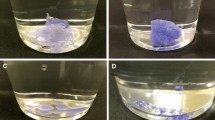Abstract
Purpose
To compare the polymerization time of n-butyl cyanoacrylate (NBCA) and lipiodol mixture in a static model and a pulsating flow model simulating embolization procedure of small caliber arteries.
Materials and Methods
The polymerization time of NBCA–lipiodol mixture was measured by the morphological changes of a glue droplet in a petri dish. For the flow model, we used a 2-mm-inner-diameter polyvinyl alcohol tube connected to a pulsation pump. Bovine serum was supplied from the pump and circulated into the system at 30 ml/min and 60 bpm. A 0.64-mm-inner-diameter silicon microcatheter was inserted into this system, and then, 0.5 ml of glue was injected into the tube. The flow cessation time was defined as the time it took to stop the serum draining from the end of the tube. Six samples of 100, 66, 50, 40, 33, and 20 vol% NBCA were assessed.
Results
The median polymerization times for each concentration were 0.12, 3.72, 12.30, 27.41, 57.68, and 63.67 s, respectively. The median flow cessation times were 0.28, 0.78, 1.43, 3.75, 4.50, and 9.29 s, respectively. The flow cessation time was significantly shorter than the polymerization time for all samples except for 100 vol% cyanoacrylate (p < 0.05).
Conclusion
The flow cessation time of cyanoacrylate glue was significantly shorter than the polymerization time in an in vitro experiment. The injected glue possibly stops the blood flow before the completion of polymerization in the vascular system.




Similar content being viewed by others
References
Sugawara S, Arai Y, Sone M, et al. Phase II Trial of transarterial embolization using an n-butyl-2- cyanoacrylate/lipiodol mixture (JIVROSG-0802). Cardiovasc Interv Radiol. 2019;42(4):534–41.
Takeuchi Y, Morishita H, Sato Y, et al. Guidelines for the use of NBCA in vascular embolization devised by the committee of practice guidelines of the Japanese society of interventional radiology (CGJSIR), 2012 edition. Jpn J Radiol. 2014;32(8):500–17.
Duffy C, Zetterlund PB, Aldabbagh F. Radical polymerization of alkyl 2-cyanoacrylates. Molecules. 2018;23(2):465.
Frodsham A, Berkmen T, Ananian C, Fung A. Initial experience using N-butyl cyanoacrylate for embolization of lower gastrointestinal hemorrhage. J Vasc Interv Radiol. 2009;20(10):1312–9.
Guillevin R, Vallee JN, Cormier E, Lo D, Dormont D, Chiras J. N-butyl 2-cyanoacrylate embolization of spinal dural arteriovenous fistulae: CT evaluation, technical features, and outcome prognosis in 26 cases. AJNR Am J Neuroradiol. 2005;26(4):929–35.
Liu HM, Huang YC, Wang YH, Tu YK. Transarterial embolisation of complex cavernous sinus dural arteriovenous fistulae with low-concentration cyanoacrylate. Neuroradiology. 2000;42(10):766–70.
Mavili E, Donmez H, Ozcan N, Akcali Y. Endovascular treatment of lower limb penetrating arterial traumas. Cardiovasc Interv Radiol. 2007;30(6):1124–9.
Baltacioglu F, Cimsit NC, Bostanci K, Yuksel M, Kodalli N. Transarterial microcatheter glue embolization of the bronchial artery for life-threatening hemoptysis: technical and clinical results. Eur J Radiol. 2010;73(2):380–4.
Takasawa C, Seiji K, Matsunaga K, et al. Properties of N-butyl cyanoacrylate-iodized oil mixtures for arterial embolization: in vitro and in vivo experiments. J Vasc Interv Radiol. 2012;23(9):1215–21.
Stoesslein F, Ditscherlein G, Romaniuk PA. Experimental studies on new liquid embolization mixtures (histoacryl-lipiodol, histoacryl-panthopaque). Cardiovasc Interv Radiol. 1982;5(5):264–7.
Oowaki H, Matsuda S, Sakai N, et al. Non-adhesive cyanoacrylate as an embolic material for endovascular neurosurgery. Biomaterials. 2000;21(10):1039–46.
Brothers MF, Kaufmann JC, Fox AJ, Deveikis JP. n-Butyl 2-cyanoacrylate–substitute for IBCA in interventional neuroradiology: histopathologic and polymerization time studies. AJNR Am J Neuroradiol. 1989;10(4):777–86.
Wang BH, Boulton M, Lee DH, Pelz DM, Lownie SP. A systemic characterization of the factors influencing polymerization and dynamic behavior of n-butyl cyanoacrylate. J Neurointerv Surg. 2018;10(2):150–5.
Suga T, Akamatsu T, Kawamura Y, et al. Actual behavior of N-butyl-2-cyanoacrylate (histoacryl) in a blood vessel: a model of varix. Endoscopy. 2002;34(1):73–7.
Ishikawa M, Horikawa M, Yamagami T, et al. Embolization of arteriovenous malformations: effect of flow control and composition of n-bytyl-2-cyanoacrylate and Iodized oil mixtures with and without ethanol in an in vitro model. Radiology. 2016;279(3):910–6.
Acknowledgements
This work was supported by JSPS KAKENHI Grant Number JP16K19841.
Author information
Authors and Affiliations
Corresponding author
Ethics declarations
Conflict of interest
The authors declare that they have no conflict of interest.
Ethical Approval
This article does not contain any studies with human participants performed by any of the authors. Institutional review board approval was not required for this study.
Informed Consent
For this type of study, informed consent is not required.
Consent for Publication
For this type of study, consent for publication is not required.
Additional information
Publisher's Note
Springer Nature remains neutral with regard to jurisdictional claims in published maps and institutional affiliations.
Rights and permissions
About this article
Cite this article
Hayashi, N., Takeuchi, Y., Miura, H. et al. Is the Cessation of Blood Flow Faster than the Polymerization of an n-Butyl Cyanoacrylate–Lipiodol Mixture? An In Vitro Phantom Study. Cardiovasc Intervent Radiol 43, 630–635 (2020). https://doi.org/10.1007/s00270-019-02393-5
Received:
Accepted:
Published:
Issue Date:
DOI: https://doi.org/10.1007/s00270-019-02393-5




